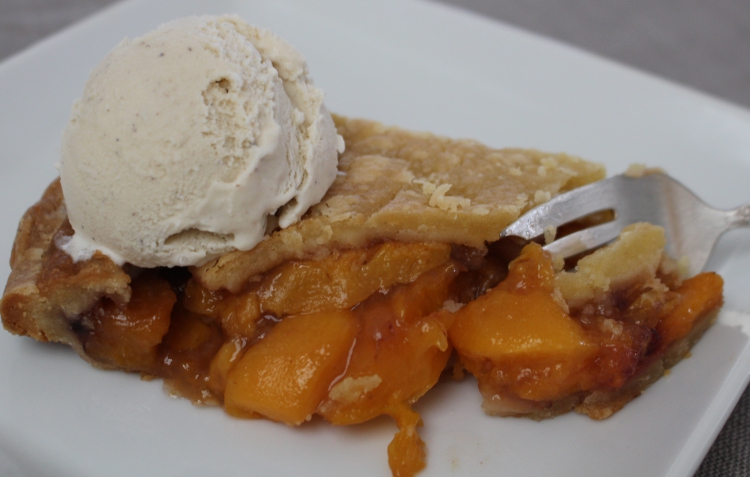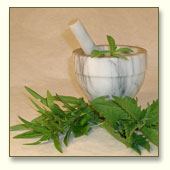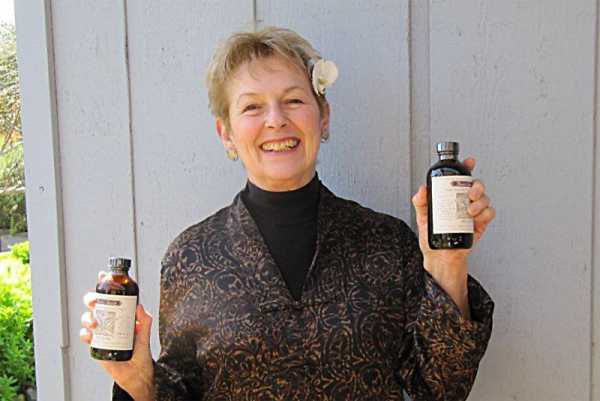
I'm amazed at how superior your vanilla is!
– Des, The Grommet
Just as “Turn On, Tune In, Drop Out,” was a catch phrase of the 1960s pop subculture,
“Calm Down, Feel Good, Lose Weight,” seems to be nearly everyone’s mantra in the first years of the new millennium. For many of us, the hectic pace of modern life leaves us anxious and exhausted, and all too often, too tired and cranky to take time for the exercise that might lift our spirits. While there is no elixir that will magically cure all that ails us, nor a perfect panacea for our harried lives, there is some useful help available as close as our kitchen cupboards.
Before the creation of antibiotics and other powerful medicines, we depended on herbs and homemade or purchased potions, as well as prayer and incantation to heal our bodies and spirits. As scientists now have the technology to study traditional folk remedies, they have found that many actually have great curative benefits. Ethnobotanists are collecting valuable information from the healers of native cultures before their knowledge of the fauna and flora of their homeland is lost or the plants and animals lost to development.  This groundswell of interest in a more natural way to heal ourselves has come about, in part, as we realize that modern medicines often have side effects or lose their potency through misuse. Although vanilla hasn’t received as much attention as many of the common popular herbs such as lavender, mint or chamomile, it has been used as a medicine for hundreds of years and its popularity is growing as more evidence becomes available about its power to heal and soothe.
This groundswell of interest in a more natural way to heal ourselves has come about, in part, as we realize that modern medicines often have side effects or lose their potency through misuse. Although vanilla hasn’t received as much attention as many of the common popular herbs such as lavender, mint or chamomile, it has been used as a medicine for hundreds of years and its popularity is growing as more evidence becomes available about its power to heal and soothe.
For the Totonaca, vanilla was a sacred herb that they incorporated into all levels of their lives. As a medicine it had a number of uses. Dr. Francisco Hernandez, apothacary to Charles II of Spain, documented some of the uses of vanilla in traditional Totonaca medicine. He wrote that the vanilla flowers were made into “collars” that served as amulets to prevent various illnesses. Vanilla beans were an antidote for certain venomous bites. Mixed with chocolate it allegedly cured flatulence. It was used for respiratory pain and congestion, deep coughs, stomach ailments, and was even made into a salve to treat syphilis.
Blends of traditional herbs and vanilla were also used. Vanilla beans, combined with mecasuchil, allegedly encouraged better circulation, opened airways, stopped aches and chills, and cured chills and fever. In conjunction with ahoyapatl, it was used to treat heart conditions. And with yoloxochitl it supposedly cured sterility. The changes in Totonaca culture over the past 75 years have resulted in their no longer using vanilla as a medicine though they do continue to use many of the other less expensive and more readily available native herbs for healing.
Europeans, and later, Americans, considered vanilla a stimulant but, paradoxically, also a treatment for hysteria and nervousness. Dr. John King wrote in the American Dispensatory in 1859 that vanilla was an aromatic stimulant useful in infusion for treating hysteria, rheumatism, and low forms of fever. “It is said to exhilarate the brain, prevent sleep, increase muscular energy and stimulate the sexual propensities.”
Vanilla was also used extensively to flavor tinctures and syrups and to perfume medicinal ointments, a practice that continues today. (Vanilla is one of three flavors most used in medications and syrups, and it is also used as a neutralizer in noxious smelling medicines.) A sweet tincture was made to treat stomach disorders, and this medicinal value was listed in the American Pharmacopoeia until 1916. For years Coca Cola syrup was a popular home remedy for an upset or queasy stomach. The syrup contained a high percentage of vanilla, which most likely was the key healing ingredient.
In 1991 Sloan-Kettering Cancer Center in New York announced in a news release that the fragrance of heliotropin – a sweet vanilla-like scent – was the most relaxing and pleasant of five fragrances tested for the reduction of anxiety and distress during a difficult medical procedure. With a grant from the Olfactory Research Fund, Drs. William Redd and Sharon Manne of Memorial Sloan-Kettering’s Psychiatry Service, tested eighty-five patients who were undergoing magnetic resonance imaging (MRI) as part of their initial workup. During an MRI scan, patients lie motionless for up to an hour in the narrow cylindrical core of the scanner. Anxiety associated with this medical procedure causes up to 10 percent of patients to terminate their scans before completion. Results of their initial tests showed that patients exposed to heliotropin while undergoing their MRI experienced 63% less overall anxiety than a control group of patients who were not given the fragrance during the scan.
An Antidote to Stress
The results of the pioneering aromatherapy tests at Sloan-Kettering prompted a series of additional tests to further determine which aromas produced the best results and how test-subjects rated the various fragrances. Heliotropin was consistently rated the most pleasant and most relaxing. 57% of participants said they would still like this scent after an hour of exposure, whereas only 25 to 30% of participants stated they would still like the other five scents involved after an hour of exposure. In a later comparison of 22 scents examined in the research series of fragrance tests, heliotropin consistently rated most favorably in terms of having pleasant, relaxing and moderately intense properties. They concluded that, “vanilla, a homey scent which may remind people of food, may be a preferred scent. Its recent rise in commercial popularity is well-deserved.” Unfortunately, after the studies were completed, Sloan Kettering did not continue the use of aromatherapy for patients. Too bad, as it worked.
I first read about the studies in the early 1990s and decided to make vanilla beans available to women I knew who were going through surgery, radiation and chemotherapy. I chose Tahitian vanilla as it contains the highest percentage of heliotropin. My research was not intended to be scientific, rather, simply possible assistance to friends. Their response was so overwhelmingly positive that I now suggest carrying a vanilla bean or two in a glass tube for anyone going through anxiety-producing events, medical or otherwise. I can now attest from personal experience that it does work. In 2003 I was diagnosed with advanced breast cancer. I always carry vanilla beans with me for the MRIs that I have every four months.
Based on my discovery that vanilla was used as a stomach calmative in American medical journals, I also provided Tahitian vanilla extract for the women to see if the liquid form was helpful. One friend, who was going through a very toxic treatment for uterine cancer, said that the extract in water was the only thing that calmed her stomach for two days after each chemotherapy treatment. I have used vanilla extract in mineral water for a queasy stomach with success and have added a small amount of extract to milk or juice for agitated children. In a recent conversation a New York attorney said that her daughter-in-law was experiencing a particularly difficult pregnancy and couldn’t keep anything in her stomach. They tried everything. Finally, the attorney put a vanilla bean in room temperature soda water and suggested her daughter-in-law sip it very slowly, breathing the aroma at the same time. The young woman’s morning sickness cleared up immediately, much to her relief and her doctor’s amazement.
In the 1990s, vanilla became the signature scent in a large variety of products, including carpet fresheners, candles, potpourri, and a large variety of perfumes. Annette Green, president of the Fragrance Foundation, an educational institution says, “It’s all part of the olfactory ‘security blanket.’” Green attributed the increased use of vanilla to the above-mentioned scientific studies. Sadly, most of the vanilla fragrances in the world are made with imitation vanilla.
A recent study at the St. George’s Hospital in London indicates that vanilla may help you lose weight. Under the guidance of Catherine Collins, a state registered dietician at St. George’s, overweight people who were given vanilla-scented skin patches found that their sweet food intake was significantly reduced, leading to greater weight loss than those given dietary advice alone. She concluded that an intensely sweet vanilla-scented candle or essence may have a similar effect though it hasn’t been proven in a test environment. Dieticians in the United States working with overweight people are also often testing clients with an array of aromas as a way to reduce food cravings. While vanilla may not work for everyone, it appears to be useful for most. Breathing the aroma of a vanilla bean in a glass tube, or wearing vanilla body products may be helpful.

There appears to be ample evidence that aroma also affects mood. The fact that vanilla is associated with home, food, security and pleasure, helps to evoke a sense of wellbeing. Realtors often use a vanilla room freshener or put extract in water in a warm oven before showing a home that’s for sale. I personally suspect that vanilla may also have a pheromone-like quality to it as numerous people have told me that they have found that vanilla essences attract attention. I have also found that men are quite drawn to the scent of vanilla and have had a number of requests for a vanilla-based after shave or cologne (I’m still looking, guys!). As the queen, I always wear vanilla fragrances. I have had people with whom I’m talking suddenly say, “I always feel so calm (or happy) around you.” Another typical response is, “What are you wearing? It smells soooo good!” (While I would like to take full credit for a scintillating personality, I have to defer to the perfume as part of my “charm.”)
Probably one of the most telling experiences of vanilla possibly mimicking a pheromone involves one of my cats. When she was younger, every time I sorted vanilla beans on the dining table, she would rush in, grab a vanilla bean, and run away with it. The rest of the day she carried the bean around with her, acting in much the same way that cats become delirious over catnip. In telling this to a research veterinarian he confirmed my suspicion that animals are attracted to the scent of vanilla by saying that they used vanilla to create stimulus and response in very sick animals. He also found that it assisted in bringing back appetite in dogs after surgery. And in other veterinary research, it has been found that the vanilla aroma and flavor are important for encouraging calm and appetite interest in nursing sows and growing piglets.
Again, my research has been done informally and is not to be considered scientific, but rather, simply deductive. It may or may not be useful for you, but it certainly is safe and affordable; if it helps you, that’s great! Be aware that many of the products on the market are made from synthetics. This is especially true in lower-priced fragrances and most candles and incense. Some candles from Asia use wicks that contain lead and are not considered safe for inhalation. Additionally, many synthetic oils, when burned, create a sticky resinous substance in the air that could potentially cause pulmonary damage when used regularly. Choose products wisely to protect your health.
In conclusion, I have been told repeatedly that vanilla helps to lift spirits and to soothe jangled nerves. To quote an e-mail I received recently from an enthusiastic “vanillaphile” in Lebanon, “I think vanilla is the greatest thing ever created. I have this passion for everything containing vanilla, and the smell drives me into great moods.” What better testimonial could I ask for? As the queen, I encourage you to calm down, feel good, and enjoy your food…but lose weight only if you need to for your health.
The following elixir is adapted from an English herbal manual. It is to be used before meals to aid in digestion and to calm the stomach.
Vanilla-Tarragon Digestive
Ingredients
1 vanilla bean, split down the center
4 sprigs of fresh French tarragon
2-1/2 cups brandy or rum
Instructions:
Place the vanilla bean, tarragon and liquor in a dark bottle and allow to steep for two weeks. Strain and place back in bottle, leaving the vanilla bean in the bottle if you wish. Take 1 tablespoon 15 to 30 minutes before eating.
I was given a small bottle of Rain’s Choice in a gift basket and I have been hooked ever since. The flavor makes all of my baking so much better! I will never use grocery store vanilla again!


© 2021. All Rights Reserved
Designed/Developed by Kat & Mouse
4 Responses
Thank you for your insight on the vanilla! I have been craving vanilla for a while now and have always believed there is a reason for a craving even if it seems weird! Your body tells you what it needs and where to get it. I have been suffering a continuous migraine for months now with little relief. So as the craving got a bit stronger I looked it up and it has led me to you.
It explains a lot and I would have never thought it was so much more then a pleasant scent. I had a heart warming chuckle when I read about you perfume choice as mine is the same and have had the same results and encounters! My greatest friends have been made by the ice breaker of what is that scent you wear?
Again thank you for your insight and your discovered blessing. It has given relief to my heart as well as giving me an idea for a dear friend who has recently come home from Afghanistan. He is having a hard time with PTSD. He is always calmed by my presence and smell and Since I can not attach my self to his leg so he can smell my vanilla-e scent, I will be making him a talisman he can carry with him.Thank you, again!
Theresia
Hi Patricia, thank you for this thorough and interesting article! I was wondering if I could tell me something. In your experience, have you found that ingesting pure vanilla (say, in the form of a tisane) has the same effect on appetite suppression as smelling pure vanilla?
This is a good question you have asked. Apparently the effect of appetite suppression is based on the sweet, full notes of vanilla’s aroma that does the trick. While a tisane of vanilla would be flavorful and possibly fragrant, I honestly don’t know if imbibing it would work unless it was very fragrant as well. Certainly a cup of a tisane would be somewhat filling and often we confuse being hungry with being dehydrated, so the tisane would help resolve that issue. I think it’s one of those “Try it to see,” issues. If you do, please let me know the results!
Warm regards,
The VQ
It’s my favourite scent and flavour.
I did find a perfume made from authentic, real vanilla but it has been discontinued. L’Artisan Parfumeur did one called Vanille Absolute and it was amazing. I nag them from time to time.